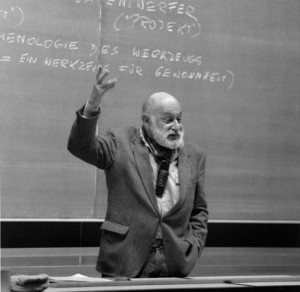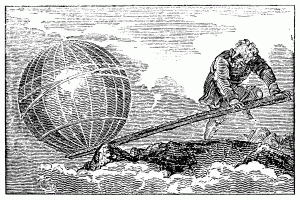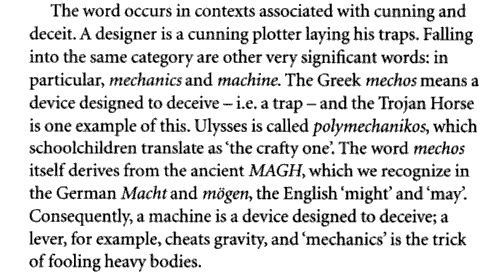Flusser argues that once we become aware of design—as deceptive, and bridging art and technology—art and technology are demystified, i.e. de-signified (stripped of their “value” or significance, i.e. their “truth [meaning] and authenticity [aura]”; cf. Walter Benjamin) . . .

Thilo Mechau, [Portrait of Vilèm Flusser,] Vilèm Flusser Archive
Give me but one firm spot on which to stand, and I will move the earth (Archimedes)
About the Word Design (1993)
In English, the word design is both a noun and a verb (which tells one a lot about the nature of the English language). As a noun, it means—among other things “intention,” “plan,” “intent,” “aim,” “scheme,” “plot,” “motif,” “basic structure,” all these (and other meanings) being connected with “cunning” and “deception.” As a verb (“to design”), meanings include “to concoct something,” “to simulate,” “to draft,” “to sketch,” “to fashion,” ‘to have designs on something.” The word is derived from the Latin signum, meaning “sign,” and shares the same ancient root. Thus, etymologically, design means “de-sign.” This raises the question: How has the word design come to achieve its present-day significance throughout the world? This question is not a historical one, in the sense of sending one off to examine texts for evidence of when and where the word came to be established in its present-day meaning. It is a semantic question, in the sense of causing one to consider precisely why this word has such significance attached to it in contemporary discourse about culture.
The word occurs in contexts associated with cunning and deceit. A designer is a cunning plotter laying his traps. Falling into the same category are other very significant words: in particular, mechanics and machine. The Greek mechos means a device designed to deceive—i.e. a trap—and the Trojan Horse is one example of this. Ulysses is called polymechanikos, which schoolchildren translate as “the crafty one.” The word mechos itself derives from the ancient MAGH, which we recognize in the German Macht and mögen, the English “might” and “may.” Consequently, a machine is a device designed to deceive; a lever, for example, cheats gravity, and “mechanics” is the trick of fooling heavy bodies.
Another word used in the same context is “technology.” The Greek techne means “art” and is related to tekton, a “carpenter.” The basic idea here is that wood (hyle in Greek) is a shapeless material to which the artist, the technician, gives form, thereby causing the form to appear in the first place. Plato’s basic objection to art and technology was that they betray and distort theoretically intelligible forms (“Ideas”) when they transfer these into the material world. For him, artists and technicians were traitors to Ideas and tricksters because they cunningly seduced people into perceiving distorted ideas.
The Latin equivalent of the Greek techne is ars, which in fact suggests a metaphor similar to the English rogue’s “sleight of hand.” The diminutive of ars is articulum—i.e. little art—and indicates that something is turned around the hand (as in the French tour de main). Hence ars means something like “agility” or the “ability to turn something to one’s advantage,” and artifex—i.e. “artist’—means a “trickster” above all. That the original artist was a conjurer can be seen from words such as “artifice,” “artificial” and even “artillery.” In German, an artist is of course one who is “able to do something,” the German word for art, Kunst, being the noun from können, “to be able” or “can,” but there again the word for “artificial,” gekünstelt, comes from the same root (as does the English “cunning”).
Such considerations in themselves constitute a sufficient explanation of why the word design occupies the position it does in contemporary discourse. The words design, machine, technology, ars and art are closely related to one another, one term being unthinkable without the others, and they all derive from the same existential view of the world. However, this internal connection has been denied for centuries (at least since the Renaissance). Modern bourgeois culture made a sharp division between the world of the arts and that of technology and machines; hence culture was split into two mutually exclusive branches: one scientific, quantifiable and “hard,” the other aesthetic, evaluative and “soft.” This unfortunate split started to become irreversible towards the end of the nineteenth century. In the gap, the word design formed a bridge between the two. It could do this since itis an expression of the internal connection between art and technology. Hence in contemporary life, design more or less indicates the site where art and technology (along with their respective evaluative and scientific ways of thinking) come together as equals, making a new form of culture possible.
Although this is a good explanation, it is not satisfactory on its own. After all, what links the terms mentioned above is that they all have connotations of (among other things) deception and trickery. The new form of culture which Design was to make possible would be [i.e.,] a culture that was aware of the fact that it was deceptive [i.e., designed]. So the question is: Who and what are we deceiving when we become involved with culture (with art, with technology—in short, with Design)? To take one example: The lever is a simple machine. Its design copies the human arm; it is an artificial arm. Its technology is probably as old as the species homo sapiens, perhaps even older. And this machine, this design, this art, this technology is intended to cheat gravity, to fool the laws of nature and, by means of deception, to escape our natural circumstances through the strategic exploitation of a law of nature. By means of the lever—despite our body weight—we ought to be able to raise ourselves up to touch the stars if we have to, and—thanks to the lever—if we are given the leverage, we might be able to lever the world out of its orbit. This is the design that is the basis of all culture: to deceive nature by means of technology, to replace what is natural with what is artificial and build a machine out of which there comes a god who is ourselves. In short: The design behind all culture has to be deceptive (artful?) enough to turn mere mammals conditioned by nature into free artists.

This is a great explanation, is it not? The word design has come to occupy the position it has in contemporary discourse through our awareness that [Thus?:] being a human being is a design against nature. Unfortunately, this explanation will not satisfy us. [No:] If in fact design increasingly becomes the centre of attention, with the question of Design replacing that of the Idea, we will find ourselves on uncertain ground. To take one example: Plastic pens are getting cheaper and cheaper and tend to be given away for nothing. The material they are made of has practically no value, and work (according to Marx, the source of all value) is accomplished thanks to smart technology by fully automatic machines. The only thing that gives plastic pens any value is their design, which is the reason that they write. This design represents a coming together of great ideas, which—being derived from art and science—have cross-fertilized and creatively complemented one another. Yet this is a design we don’t even notice, so such pens tend to be given away free—as advertising, for example. The great ideas behind them are treated with the same contempt as the material and work behind them.
How can we explain this devaluation of all values? By the fact that the word design makes us aware that all culture is trickery, that we are tricksters tricked, and that any involvement with culture is the same thing as self-deception. True, [+] once the barrier between art and technology had been broken down, a new perspective opened up within which one could create more and more perfect designs, escape one’s circumstances more and more, live more and more artistically (beautifully). But [-] the price we pay for this is the loss of truth and authenticity. In fact, the lever is about to lever all that is true and authentic out of our orbit and replace it mechanically with perfectly designed artefacts. And so all these artefacts become as valuable as plastic pens, become disposable gadgets. This becomes clear when we die, if not before. Because despite all the technological and artistic arrangements we make (despite hospital architecture and death-bed design), we do die, just as other mammals die. The word design has managed to retain its key position in everyday discourse because [i.e.,] we are starting (perhaps rightly) to lose faith in art and technology as sources of value. Because we are starting to wise up to the design behind them.
This is a sobering explanation. But it is also an unavoidable one. A confession is called for here. This essay has had a specific design in mind: It set out to expose the cunning and deceptive aspects of the word design. This it did because they are normally concealed. If it had pursued another design, it might, for example, have insisted on the fact that “design” is related to “sign”: a sign of the times, a sign of things to come, a sign of membership. In that case, it would have given a different, but equally plausible, explanation of the word’s contemporary situation. That’s the answer then: Everything depends on Design.
“About the Word Design” [“Vom Wort Design“]. The Shape of Things: A Philosophy of Design [Vom Stand der Dinge: Eine Kleine Philosophie des Design]. Trans. Anthony Mathews. 1993. London: Reaktion Books, 1999. 17-21. Also translated as “On the Word Design: An Etymological Essay.” Trans. J. Cullars. Design Issues 11.3 (Autumn 1995): 50-53. Also published in Alex Coles (ed.), Design and Art (London: MIT P, 2007) and Ben Highmore (ed.), The Design Culture Reader (London: Routledge, 2008).
The annotations are mine.


 sphaira (Gk)
sphaira (Gk)








 (205)
(205)
